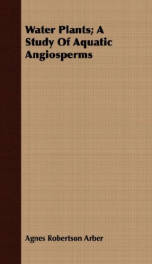water plants a study of aquatic angiosperms

PREFACE. WATER-POw Which , a s formerly the chief reliance of mankind in industry, has been greatly overshadowed in recent times by the cheapness of coal and the development of the steam-engine. This condition, while permanent to all immediate practical intents, is nevertheless, upon a broad view of the subject, merely temporary. Two hundred and fifty years ago, when unbroken forests stretched from the Penobscot to the Wabash, the idea of a scarcity of wood and timber appeared grotesque. At the present day, the idea of the exhaustion of existing deposits of coal appears equally so. Nevertheless that time will certainly come. Our depos-its of coal are finite every ton taken from the miner leaves a t n less to be mined. Coal does not have the power of reproduction even to the extent that wood and timber have. It does not, like water, have the power of rising in the form of vapor after having developed energy by descending. Coal deposits are simply an enormous store of fuel in rapid process of destruction by fire. Water, on the other hand, will continue to stand mankind in good stead long after the reluctant earth has yielded up its last ton of coal at least, long after coal has become too inaccessible and consequently too expensive to be used for power. Recent remarkable developments in electricity and other . modes of transmitting mechanical energy have recalled waterpower to something like its former position in industrial economy. Whereas formerly it was necessary that the inudustry should be located at the waterfall, it is now possible to make large use of water-power for industries located many miles distant. These changed conditions have given a new interest to water-power and directed the, attention of investors to sources which formerly appeared entirely outside the range of practical consideration. They have also led to some noteworthy improvements in utilization, development, and transmission of power. These improvements are embodied in records of engineering societies, in the pages of engineering journals, in the plans of skillful engineers, in catalogues and advertisements of machinists. It has appeared to the writer no unworthy task to review these sources of information, to select what appears worthy of preservation, or necessary for the illustration of the subject and put it in an accessible and preservable form. In other words, to bring the entire subject of water-power up to date. This is in no sense an elementary work. It does not deal in axioms, definitions, or the elements of science. It assumes the reader to be possessed of elementary notions of mechanics and mathematics. It discusses some subjects which cannot be made clear without recourse to the higher mathematics, and in these cases the writer does not hesitate to plunge boldly into . these branches of analysis. He does not conceive it necessary to offer any apology for this proceeding. It is true that there are successful engineers-successful at least in the sense of obtaining and retaining lucrative employments-who affect to despise mathematical knowledge, and make a boast of their ignorance of these branches. As well might the lawyer boast his ignorance of the common law. Mathematics is the common law of engineering. It is to engineering what the common law is to the legal profession...
Info about the book
Author:
Series:
Unknown
ISBN:
0713127511
Rating:
3.5/5 (2)Your rating:
0/5
Languge:
English
Users who have this book
Users who want this book
What readers are saying
What do you think? Write your own comment on this book!
write a commentif you like water plants a study of aquatic angiosperms try:
Other books by this author
Do you want to read a book that interests you? It’s EASY!
Create an account and send a request for reading to other users on the Webpage of the book!

